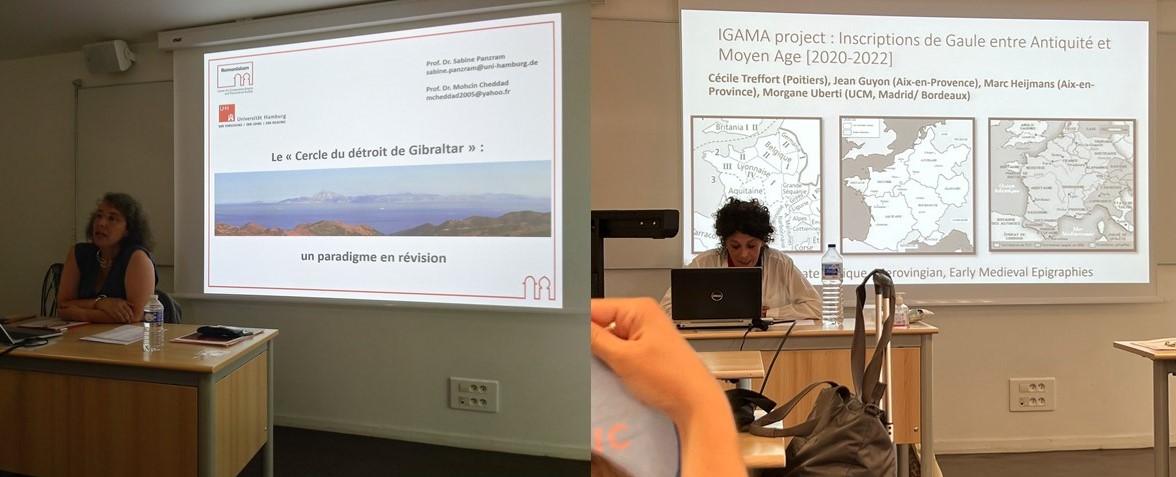It is that time of the year again! After the summer break the conference season is back and, it’s back with a vengeance. When the “academic summer” ended in August, and we opened our calendars, we realised that an autumn with a full programme awaited us.
The first steps in September
The first conference of the new academic year was the Congressus Internationalis Epigraphiae Graecae et Latinae, or in short CIEGL. This conference takes place once in five years and brings together epigraphers from all over the world to discuss to discuss the latest contributions and upcoming research in the field of epigraphy. From August 29 to september 2nd epigraphers met in a beautiful and warm Bordeaux. From ATLAS we had several members present at the conference. Our director Sabine Panzram organised a whole panel called “L’épigraphie du « Cercle du détroit de Gibraltar »” in which the scientific director of the Casa de Velázquez for the ancient and mediaeval periods, Gwladys Bernard, also participated. In the session “Les traditions épigraphiques après Dioclétien” our ATLAS member Morgane Uberti presented her work. Pieter did not present a paper as such, but presented with the new WebGIS of the LatinNow team to which he also belongs: www.gis.latinnow.eu.

This first conference was followed by the IV Coloquio de Arqueología e Historia Antigua de Los Bañales, entitled ”Pecunia communis: economic resources and sustainability of small Hispano-Roman cities”, which took place from 22 to 24 September in Ejea de los Caballeros and Uncastillo (Zaragoza). Several members of ATLAS also participated in this event, as we tweeted a few days ago. Darío Bernal Casasola dedicated his presentation to the garum cities in Hispania, focusing especially on one of our case studies, Baelo Claudia. Alfred Hirt, for his part, presented a detailed analysis of metallurgical production in the Iberian Peninsula during the Roman period, emphasising the importance of mineral resources. Finally, our postdoc, Ada Lasheras González, presented the interesting Circ-E project, in which she also participates and which is dedicated to the study of logistics and the principles of the circular economy in Hispano-Roman cities. Our director, Sabine Panzram, joined us on the last day of the colloquium during the visit to the site of Los Bañales.

The conferences ahead
In October the annual TOLETUM workshop will take place. For more information follow this link. Even though no ATLAS team members will be presenting, TOLETUM is close to our heart, not only because Sabine Panzram is the founder and co-organizer, but also because we all attended one of these workshops in the past few years. TOLETUM XIII “Valles fluviales de Hispania en perspectiva diacrónica” will treat different aspects of river valleys in antiquity from the third century BCE to the ninth CE.

In November the Warburghaus will host another conference co-organised by Sabine Panzram, incredible is the number of conferences she is organising, Shifting Cities in the Iberian Peninsula, III BC – IX AD. At this conference a few ATLAS members will present their work. It starts on Thursday with the co-presentation of our Hamburg members Sabine Panzram and Pieter Houten on the possible transformation of the civitates in Late Antiquity. On Friday, our colleague from Casa de Velázquez, Ada Lasheras González, together with Joan Negre and Francesc Rodríguez Martorell, will present the changes observed in the cities of Ṭarrakūna and Ṭurṭūša in the first centuries of al-Andalus. She will be followed by our member María Teresa Casal-García on our case study Qurtuba. On Saturday we continue with Sonia Gutiérrez Lloret on the urbanism of the southeast of the Peninsula. All in all a promising conference.
In December the conference season comes to an end with Africa Romana XXII. Although the focus on the Julio-Claudian period is a bit far from the focus of ATLAS, several of our members will be presenting papers here. First, we will have Rubén Olmo-López presenting his work on magistrates. On Saturday Sabine Panzram, Stefan Ardeleanu and Pieter Houten will present a joint paper on imperial cult in North Africa.

Amidst these conferences our research groups have been meeting in preparation for what maybe is the most important gathering for ATLAS:
The ATLAS Workshop in La Rochelle
On November 9th and 10th we will have the third ATLAS workshop at the Université La Rochelle. We expect to have the programme finished in a few days and publish it on our website, as usual. We can give a sneak preview of the idea behind this workshop. Each research group will have a timeslot of one hour to present their work for ATLAS. The group can opt for two 20 min presentations followed by two 10 minute discussions, or have one longer presentation with a longer discussion. We already know of some groups opting for one or the other, so the programme will be varied in that regard. In addition to the set up, we have invited Marc Heijmans of the CNRS, the director of another atlas project: Atlas topographiques des villes de Gaule méridionale. He will present his work on the cities of southern Gaul in Late Antiquity. We will also have the opportunity to welcome Didier Bayard, from INRAP, who will present a synthesis on the cities of northern Gaul in Late Antiquity.
We look forward to all these opportunities to disseminate our work and exchange with colleagues. Above all we look forward to the ATLAS workshop, where we have the chance to meet our project members and exchange with a specific focus on urbansim in Late Antiquity.

